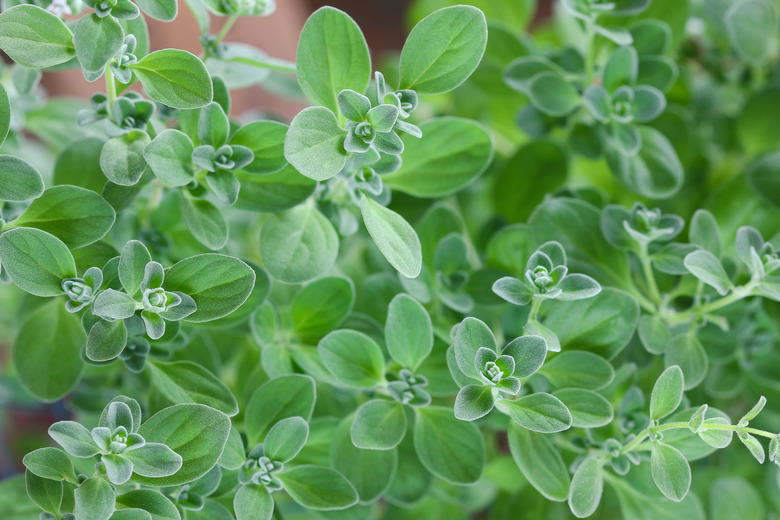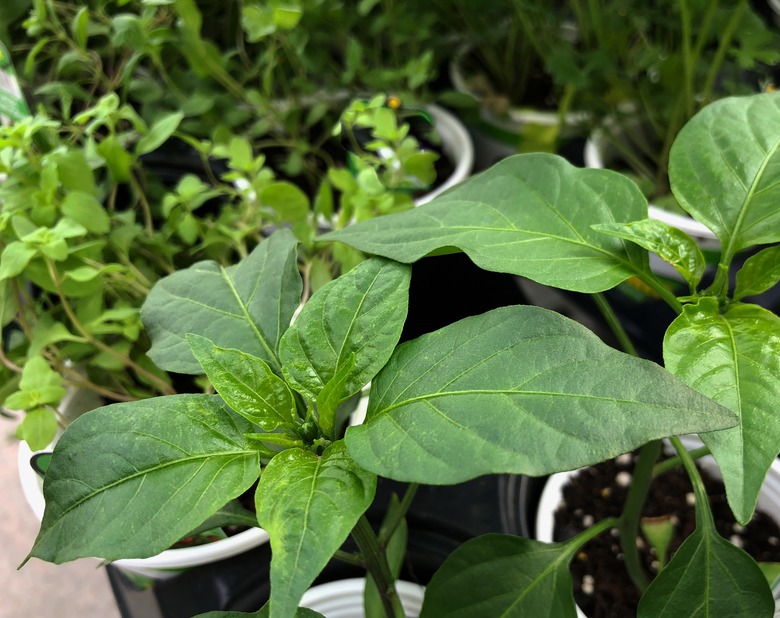How To Grow Marjoram
We may receive a commission on purchases made from links.
Some say that marjoram (Origanum majorana, USDA hardiness zones 9-10) represents joy and happiness, and it certainly adds charm to the garden. The plant's delicate gray-green leaves add a subtle hint of color, as do its tiny pale-purple or white flowers that appear in late summer. Part of the mint family (Lamiaceae), this cousin of oregano also creates a pleasant scent and grows well in containers both indoors and outdoors.
Technically a perennial, gardeners in the United States usually grow this Mediterranean native as an annual or indoor plant. Gardeners living in the South, however, may be able to coax their marjoram into coming back the next year.
Best Uses for Marjoram
Best Uses for Marjoram
Reaching only about 1 or 2 feet high, marjoram is a fairly compact plant that works well as a border or edging plant. Marjoram also grows well in rock gardens. The sweet smell that marjoram emits is quite pleasant, making it a nice addition to patios and outdoor living spaces, where you can enjoy the fragrance. The herb also attracts butterflies and other beneficial insects to the garden.
Most gardeners plant this herb for use in the kitchen, however. Marjoram adds a slightly woody and somewhat citrusy flavor to salads and most meat dishes. If you're using fresh marjoram leaves, it's best to add them when your dish is almost done. Too much heat can dull the flavor of fresh marjoram. This isn't the case with dried herbs. When cooking with dried marjoram, add it earlier in the cooking process so it has time to rehydrate.
How to Grow Marjoram
How to Grow Marjoram
- Common Name: Marjoram, sweet marjoram
- Botanical Name: Origanum majorana
- When to Plant: Wait until after the last frost when soil temperatures are 70 degrees Fahrenheit
- USDA Zones: 9-10 (as a perennial); all zones as an annual
- Sun Exposure: Full sun
- Soil Type: Moist, well-draining soil
- When it's in Trouble: Droopy, wilted leaves
- When it's Thriving: Red or brown sturdy stems, green and silver leaves
Starting Marjoram From Seed
Starting Marjoram From Seed
The simplest way to grow marjoram from seed is to wait until the danger of frost has passed and sow seeds directly into the garden. When you're ready to sow, soak your marjoram seeds in water overnight. This will make them germinate faster. While you're waiting for your seeds to soak, work some aged compost into the top 8 inches of soil.
After soaking, sow your marjoram seeds 12 inches apart, covering each seed with about 1/4 inch of soil. Water the seeds gently and keep the soil around them moist. You'll see seedlings poking up through the ground in about 14 to 21 days.
If you wish to start earlier, sow your marjoram seeds in seed trays eight to 10 weeks before the last frost. Place the seed trays in a warm area where you can keep the soil temperature around 70 degrees Fahrenheit. Keep the soil moist but don't let it get soggy.
Marjoram seedlings need lots of light. If you start them indoors, place them under a light for 16 hours a day and turn off the light for eight hours every night. Adjust the height of the light as the seedlings grow, keeping them 3 or 4 inches beneath the light source. Use an LED grow light rather than an incandescent bulb, as the incandescent bulb will get too hot.
Starting Marjoram From a Seedling
Starting Marjoram From a Seedling
After the last frost, transplant your seedlings outdoors. Leave them outside for a few hours at a time and leave them out a little longer every day for about a week. When the young plants have adjusted to the outdoor climate, it's time to transplant them.
Space your planting holes 12 inches apart, making each one deep enough to cover the entire root ball of the marjoram seedling. Water the newly planted seedlings and mulch around them about 2 inches deep to minimize competition from weeds while the plants are still young.
In What Zone Does Marjoram Grow Best?
In What Zone Does Marjoram Grow Best?
Marjoram likes warm weather and grows as a perennial only in USDA plant hardiness zones 9 and 10. Gardeners growing marjoram in zones 7 and 8 may or may not see their plants come back the next year. In these zones, you'll need to winterize your marjoram. However, that won't guarantee its return.
Gardeners north of USDA zone 7 need to grow marjoram inside or treat it as an annual plant.
When Should You Plant Marjoram?
When Should You Plant Marjoram?
Plant marjoram in the spring after any danger of frost has passed. Ideally, marjoram enjoys a soil temperature that is around 70 degrees Fahrenheit. In zone 6, for example, this means planting in May or June, while those in warmer areas could plant marjoram as early as March or April.
Soil, Sunlight and Water Recommendations for Marjoram
Soil, Sunlight and Water Recommendations for Marjoram
Marjoram enjoys basking in full sun, but it will tolerate a bit of afternoon shade if it must. The plant prefers a slightly acidic soil with a pH of 6.7 to 7.0 but will tolerate less than perfection in this department as well. Marjoram also needs about 1 inch of water a week during the growing season, but too little water is better than too much for this somewhat drought-tolerant herb.
Keep up with weeding chores while your marjoram is young and too small to compete with weeds for water and soil nutrients. This robust grower will eventually hold its own against weeds and doesn't usually require fertilizer or other help. If you wish, however, you can give the plant some compost tea two or three times during the growing season.
For optimal growth, prune marjoram in late spring before the flowers appear to encourage bushy growth. Do so again midway through the summer to prevent your plants from developing woody stalks. This is cause for concern only in areas where marjoram grows as a perennial. Pruning won't be an issue if you're growing the plant as an annual herb.
How to Winterize Marjoram
How to Winterize Marjoram
If you live north of USDA hardiness zone 7, there is no way to winterize your marjoram plant. The only way the plant will survive the winter is if you plant it in a container and bring it inside for the winter.
If you live in USDA zone 9 or 10, your marjoram should easily grow as a perennial without any special attention from you in the winter. Like other perennials, the plant will die back in the fall and revive itself again in the spring.
Those living in USDA zones 7 and 8, however, may wish to try keeping their marjoram outdoors through the winter. To do so, wait for your marjoram to die back in the fall. When it does, cover it in 12 inches of straw mulch to insulate it during the winter. This insulation might be enough to keep the marjoram dormant but alive until spring.
Note that marjoram is very sensitive to cold weather. Even if you insulate the plant, it might not come back after a cold winter. If you're attached to your plants and keeping them is important to you, move them inside for the winter to be sure.
How to Harvest Marjoram
How to Harvest Marjoram
You can begin harvesting the tasty leaves of the marjoram plant four to six weeks after planting when the plant stands about 4 to 6 inches tall. To do so, cut the leaf cleanly off the stem at the base. Marjoram tastes best when harvested just after the flower buds appear on the plant but before they open, but you need not wait until flower buds appear to enjoy your herb.
If you notice flowers on your marjoram when harvesting, pinch them off to encourage more leaf growth. Marjoram will continue to produce until killed or stunted by frost. If you can't use your marjoram leaves right away, you can dry or freeze them for a taste of summer when the weather is cold. It's best to harvest leaves after the flower buds appear but before they open if you plan to dry them. To dry marjoram, tie stems together in small bundles and hang them upside down in a cool, dry place.
Common Pests and Other Problems for Marjoram
Common Pests and Other Problems for Marjoram
Although they may look cute and innocent hopping around the yard, don't be fooled. Rabbits are savage little garden demons who can decimate a marjoram crop. Unlike insect damage, which causes ragged edges, rabbits leave behind cleanly sheared leaves and stems. If it's a clean cut, it was probably a rabbit.
If rabbits are devouring your plants, consider planting onions or spreading dried sulfur or powdered red pepper around the garden. The smell of these items tends to repel rabbits. You can also use chicken wire to fence off areas of your garden where you want to keep rabbits out. Bury the chicken wire 6 inches deep and make sure it's at least 4 feet high. Bend the top of the fence out from the garden to deter climbing.
Thrips, aphids and spider mites also like marjoram and may visit your garden. Aphids and mites are easily dislodged with a spray of water, and you can discourage thrips by laying sheets of aluminum foil between your plants. If you see a lot of insects or if a shiny foil garden isn't your thing, apply insecticidal soap to keep these and other insect pests at bay.
Common Diseases for Marjoram
Common Diseases for Marjoram
Marjoram can suffer from both powdery and downy mildews as well as botrytis blight. To avoid all three, space your marjoram plants 12 inches apart so that air can easily circulate around them. Water your plants by directing water at the roots rather than the foliage and stay out of the garden when it's wet.
Rust can also affect marjoram. You can generally avoid it by delaying your planting a bit in the spring since rust tends to be worse in the beginning of the growing season. If you do see rust on a plant, remove it before the problem can spread.
Keeping your garden free of weeds and debris is generally enough to avoid problems with marjoram.


